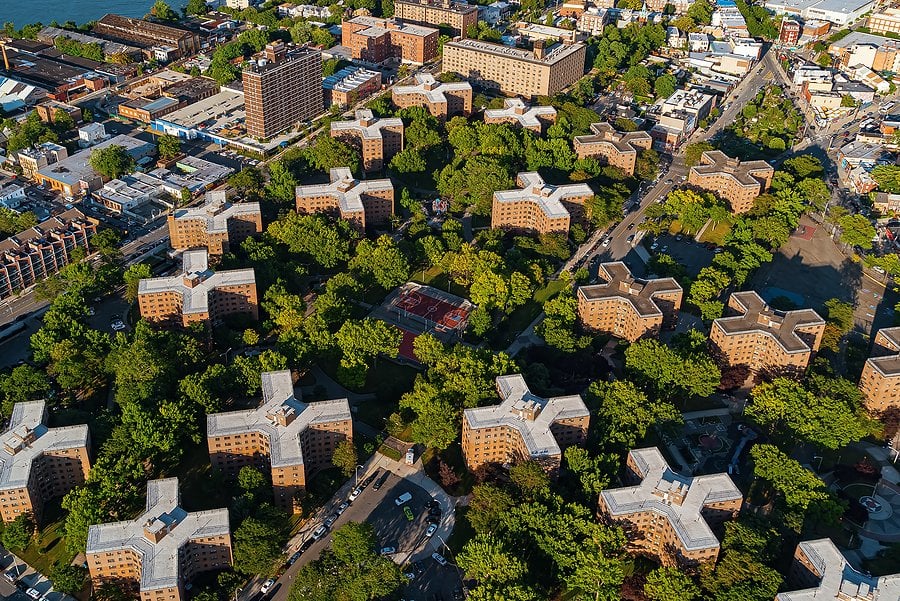 Stuyvesant Town-Peter Cooper Village
Stuyvesant Town-Peter Cooper Village
Stuyvesant Town-Peter Cooper Village is a large private development on the east side of Manhattan. The complex, which was built shortly after World War II, consists of 110 red brick apartment buildings spread over 80-acres of land stretching from First Avenue to Avenue C, between 14th and 23rd streets. The development is split up into two parts – Stuyvesant Town or StuyTown south of 20th Street and Peter Cooper Village north of 20th Street. Together, these two developments contain 11,250 apartments.
Plans for the development of the Stuyvesant Town-Peter Cooper Village began in 1942. It opened its very first building in 1947. The complex has changed hands several times and was most recently sold in 2015 to Blackstone for $5.45 billion. This development is part of Manhattan Community District 6.
Purchase by Blackstone
In 2015, Blackstone, which is one of the world’s largest financial firms, got a $220 million financing package from the city in exchange for preserving 5,000 affordable units at Stuyvesant Town and Peter Cooper Village complex for a period of 20 years. However, the state’s reforms to the rent-stabilization law led the developer last summer to stop major renovations and keep up to 50 units vacant, the Real Deal reported last year.
Blackstone suspended renovations including fixing lead paint issues in the buildings and larger renovation projects in light of the recent legislation. The Real Deal reports that the real estate industry was caught off guard by the introduction of the laws in June 2019. Blackstone played a key role in the lobbying effort against the laws.
Local Law 1 and What it Says
Local Law 1 is New York City’s Childhood Lead Poisoning Prevention Act of 2003. The purpose of this law is to prevent lead paint hazards in housing and day care facilities. The law requires landlords (building owners) to follow certain rules to prevent lead poisoning among children. Local Law 1 applies to apartments and common areas of buildings built before 1960 or built between 1960 and 1978 if your landlord knows that the building has lead paint; buildings that have three or more apartments; and units where children 6 years of age and under live or visit.

Lead Paint Inspection and Repair
If your landlord knows that a child 6 years of age or under lives in an apartment, he or she is required under the law to inspect the apartment for peeling paint and other lead paint hazards at least once a year.
If you are a tenant, every January, your landlord (building owner) is required under the law to send you a notice asking if a child 6 years old or younger lives in your apartment. If you have a new baby, or if a child 6 years of age or younger comes to live with you, it is important that you notify your landlord.
The law requires landlords to check apartment units for the lead paint hazards including but not limited to peeling paint, crumbling plaster, broken wood frames or molding, painted doors and windows, painted baseboards, molding and doors, and “chewable” surfaces including all painted window sills and other surfaces that may have been chewed by children. The law also specifically states that landlords should only use qualified workers for repairing lead paint and sets forth standards of repair.
Lack of Enforcement
In September 2018, a coalition of environmental and housing groups in New York City came out with a report stating that the city’s regulators have not taken a single enforcement action against private landlords for failing to conduct annual lead paint inspections in the 14 years since the ambitious lead poisoning prevention law was passed. Local Law 1 had the ambitious goal of ending lead poisoning in New York City by 2010, but more than 61,000 children 6 years old or younger have had elevated blood lead levels since 2010.
The report has a number of specific examples of how New York City failed to take enforcement action against negligent landlords. The most recent Department of Health and Mental Hygiene data shows that 97% of the children who suffered lead poisoning since the beginning of 2010 resided in private housing.
What’s worse, the report found that New York City has barely collected any of the $2 million in fines racked up by landlords who have violated rules governing safe work practices. By contrast, the Department of Health and Mental Hygiene, which enforces Local Law 1, has collected $5 million related to infractions by street vendors.
The report included a set of recommendations to the city such as ramping up the collection of fines, establishing escalating fines for repeat offenders, and introducing the possibility of criminal penalties for the most serious violations. It also urged the city to address the silo mentality in multiple city agencies who work on lead issues, which is often a source of confusion for citizens who report problems and complaints.
Why Lead is Dangerous
Lead is an extremely toxic metal that can cause serious health problems. The neurological and behavioral effects of lead poisoning in children can be permanent with devastating impact on families. Young children are especially at risk of lead poisoning because their developing brains and nervous systems are particularly vulnerable to lead-induced injuries. Young children also absorb and retain lead at a higher rate than older children and adults.
Environmental factors cause older children to be at risk as well. Acute lead poisoning can cause kidney failure, convulsions, coma and even death. But, even lead concentrations once thought to be safe (below 5 milligrams per deciliter of blood) are now known to result in decreased intelligence, behavioral issues and learning disabilities among children. Studies show that lead damages children’s nervous systems and delays brain development.
When lead poisoning issues are left unaddressed, children who experience prolonged lead exposure may suffer from impaired kidney function, neurobehavioral impacts and even cognitive dysfunction. These effects have lifelong impacts on a child’s IQ and behavior leading to attention deficit disorder, reduced educational attainment and increased anti-social tendencies. Lead is also harmful to pregnant women and may cause adverse health effects including premature births and miscarriages.
Understanding Your Rights
If you know you are moving into an older housing unit, such as one in Stuyvesant Town-Peter Cooper Village, which was built before 1978, your risk for lead paint contamination may be higher. Landlords (building owners) are required to disclose to their tenants whether the home was built before 1978. They are required to give you a pamphlet on how to protect your family from lead and they must write out a disclosure list of any known lead paint hazards. If you have children, plan to become pregnant while living in the home or intend to have young children living with you, you may want to look out for signs of damage such as paint chipping or peeling.
If tests reveal that your child’s blood lead levels are high, your doctor may refer you directly to the local health department. It is in your best interest here to contact an experienced New York City lead poisoning lawyer who will fight hard to protect your rights and serve as your advocate. If your child’s blood lead levels are below the state-mandated intervention levels, you may be able to work with your landlord to have the lead paint removed or repaired so your child can remain healthy in your current home.
It may be a good idea to write a letter to your landlord (building owner) asking them to repair the problem. While this may not be effective in forcing the landlord to act, it may still help protect your rights. This action helps form a starting point where you can demonstrate that the landlord knew about the dangerous lead paint. This may essentially help you prove negligence (carelessness) at a later time, should you need to do so. When you put the lead paint issues in writing, it establishes a paper trail, which may force landlords (building owners) to disclose all known lead paint hazards and violations to people who move into the development in the future. It’s always good to have on record any conversations you’ve had with your landlord. Include in your letter the following details:
- How you discovered your child has suffered lead poisoning, such as a blood test.
- Which part of your unit has chipping or peeling paint.
- Who in your household is in danger because of this issue. If you have children, list their ages.
- Provide your landlord (building owner) with a reasonable deadline to solve the problem.
- Keep a copy of this letter for your records.
If your landlord (building owner) fails to take appropriate action, you may want to call your health department and have them take action against the landlord. Different health departments have different levels of enforcement depending on the urgency of the situation and their own internal regulations. If your landlord has promised to fix the lead problem, but has not done so, you can file a further complaint or move out of the unit. Contact an experienced New York lead poisoning lawyer to obtain information about pursuing your legal rights.
An experienced New York City lead poisoning lawyer will be able to help you file the lawsuit and compile the evidence that is required to hold the party accountable for its negligence (carelessness). As a resident of public housing, you and your family have the right to live in a safe and healthy environment. The landlord has a duty as the property owner and manager to provide a safe and healthy environment for all residents.
Filing a Lead Poisoning Lawsuit
Whether you have been living as a tenant at a private apartment complex such as Stuyvesant Town-Peter Cooper Village or in a public housing unit (the Projects), please remember that you have legal rights. If your child has been diagnosed with high blood lead levels, regardless of whether you live in public or private housing, you may be able to file a personal injury lawsuit against the NYCHA (the Projects) or private landlords for damages. Those who have been affected can seek compensation for damages including medical expenses, cost of diagnostic tests, permanent injuries, lost income and benefits, disabilities, past and future pain and suffering, etc.
If your child has been affected by lead poisoning, the experienced New York personal injury attorneys at the Law Offices of Kenneth A. Wilhelm can help you better understand your legal rights and options, and also fight hard to recover just compensation for you. You may be able to seek compensation for damages including medical expenses, cost of diagnostic tests, permanent injuries, disabilities, past and future pain and suffering, etc.
Our firm recovered $1,162,500 for a child who suffered lead poisoning from paint in her apartment. The child’s injuries were subtle and difficult to recognize. We recovered $162,500 above the $1 million dollar total policy in this case. Despite the judge’s efforts to settle the case for $950,000, we fought hard and recovered $162,500 more than the insurance full policy of one million dollars. Also, one of our clients obtained a verdict for $43,940,000 and another of our clients got a verdict for $23,500,000, both in medical malpractice cases.
Please contact us TOLL FREE 24 hours a day, 7 days a week at 1-800-WORK-4-YOU (1-800-967-5496). WE CAN EVEN COME TO YOU. There is no attorneys’ fee unless we recover money for you. We can also help with personal injury and medical malpractice cases in New York, New Jersey, Connecticut, Pennsylvania, or Florida. If you have been seriously injured in any of the 50 U.S. states, please call us and we will try to help you with your case.











 Stuyvesant Town-Peter Cooper Village
Stuyvesant Town-Peter Cooper Village